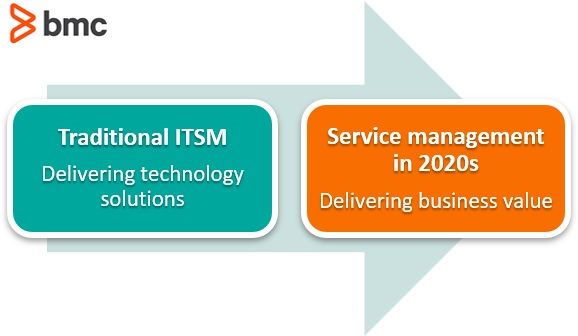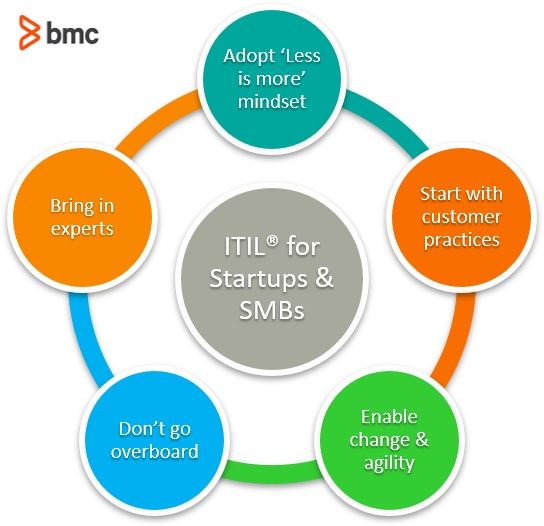With the excitement that comes with starting up a new business, the idea of service management may be far from your mind. Or, perhaps you’re an established small- or medium-sized business (SMB) that thinks true ITSM is only for the big enterprises.
Don’t get caught in these mistakes.
Getting things right with service management will improve your chances of establishing a successful business in the long term. Creating a framework to support service delivery early on will allow you to build a culture of:
- Providing excellent service to customers
- Delivering business value to shareholders

In this article, I’ll talk about how service management requires critical practices that startups and SMBs must master as soon as possible—and how ITIL® is the way to implement those practices.
Reputation depends on service management
Any business lives or dies on its reputation. The essential building block for this reputation? How you interact with—and respond to—your customers.
Many a start-up has failed to meet its potential. Not because of the quality of their products. Not because of lack of funding. They fail because of poor customer service. Service management provides the framework you need to satisfy and build your customer base.
Download Now: ITIL 4 Best Practice e-Books
These all-new for 2020 ITIL e-books highlight important elements of ITIL 4 best practices. Quickly understand key changes and actionable concepts, written by ITIL 4 contributors.
But many companies, no matter the size, will say to me, “Customer service isn’t our core business.” If customer service is not your core business, what do you need to put in place to provide the best level of service to your customers? Smaller companies and brand-new businesses alike know exactly how valuable every customer is.
The ITIL framework for service management
By far the most widely adopted service management framework is ITIL. Now in its fourth iteration, and with a clear focus on business value, any start-up should be including a plan to adopt the parts of the framework best suited to their initial requirements during their business planning phase—before delivering a single product to a customer.
It will be too late to initiate service management practices when a manufacturing glitch causes thousands of faulty products to be delivered to your eager customer base. The road to success for most start-ups is paved with missteps and stumbles, how you react to these will determine whether you are one of the small percentage of successes in the start-up space, or just another casualty of a marketplace that demands excellence.
For small- and medium-sized companies, your experience might be different. Perhaps you’ve handled those missteps and stumbles, but you’re not quite where you want to be with service delivery and the customer experience.
Luckily, you can take the knowledge and experience you have and, at any time, use ITIL to guide you towards modernizing service management.
ITIL 4 practices for SMBs and Startups
Looking at the ITIL 4 framework for the first time will be daunting, so where should you start?

Adopt a “less is more” approach
I recommend a ‘less is more’ approach to adopting the framework. Look at your business model and your product. Try to get a picture of where in the supply chain you are most likely to experience difficulties. Take a close look at the framework and decide which practices are most likely to prevent or ease the issues you are likely to face.
Start with customer facing practices
Customer facing practices are likely to give the best bang for your buck. Look at the practices that make up this part of the framework—incident management and service request management will be a good start.
In order to establish these practices, you are going to need to engage with your customers, they need to have a point of contact, an easy entry into your business to get the help and information they require. This is most likely to be achieved by establishing a service desk function.
Enable change and agility
Especially in the start-up world, two supporting practices likely to provide real business value are:
The combination of these with incident management and request management will provide:
- The engagement you need with your customer base.
- The agility you need to quickly diagnose problems and initiate the changes needed to resolve them.
Where ITIL and service management in general can provide the difference between life and death for any company is by providing a clear, well understood process with defined responsibilities. This means that the right people will be concentrating on solving customer issues and keeping them happy, leaving others to concentrate on building the business.
Don’t go overboard
The saying ‘rigour without rigmarole’ is a good one to keep in mind when deciding just how much service management ceremony you need to bring into your start-up or small company.
Adopting just the right level of service management is critical. This ensures that you bring just enough process to the way your operational and product teams manage launched products. But not too much process! This will hamper the pace your team needs in order to adopt or grow to meet market requirements.
Bring in an expert
One final piece of advice I would give: if you do not have service management expertise within your team, bring some in, at least on a temporary basis. Getting this part of the service value chain right will make all the difference in the longer term.
Service management tools
Does all this mean that you need to invest in a service management toolset? The purist in me would say that good service management is not dependent on a toolset.
But, in reality, you will have a far easier road to travel if you start your journey with a scalable ITSM toolset that will grow with you as your business expands. The right toolset will allow you to automate many processes, leaving little to chance, ensuring that customer issues and enquiries are not lost in the chaotic period that follows new product or service launches.
Buying an ITIL-based toolset allows you to benefit from those who have gone before you. Modern toolsets have been refined and improved by the experience of thousands of service management practitioners who have used them before you. This collective wisdom is what will allow you to get up and running with quality service management systems in a relatively short period of time.
(Learn how to evaluate and choose an ITSM tool vendor in 4 steps.)
The time is now
It is never too late to establish your service management capability. If you’re brand new to it, you’re in the right spot. Even if you have neglected this critical business function, it is possible to stand up an effective customer facing front door very quickly.
Additional resources
For more on this topic, explore the BMC Service Management Blog and these resources:








